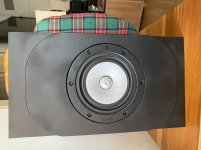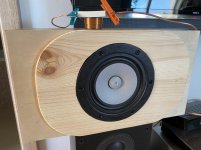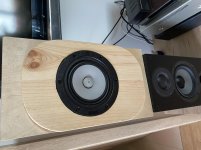Hi Guys, I am building my first bookshelf speaker ever.
To keep my first build as simple as possible, I decided to reuse the enclosure from my old Wharfedale Valdus 200 s(12 Litres) and bought Alpair 10p fullrange drivers that should fit nicely, but by the spec they require a bit more enclosure volume for good bass extension.
I can sacrifice sensitivity so is baffle step compensation circuit a way to go to boost the bass?
I already built the bass reflex prototype, but have to tweak the bass (+8db) via amplifier tone controls to get the bass a like. I would like to het the same result without using tone controls.
I am wondering whether baffle step compensation loss circuit starting at let’s say 100 hz is a way to go.
Many thanks for any hint,
Pavel
To keep my first build as simple as possible, I decided to reuse the enclosure from my old Wharfedale Valdus 200 s(12 Litres) and bought Alpair 10p fullrange drivers that should fit nicely, but by the spec they require a bit more enclosure volume for good bass extension.
I can sacrifice sensitivity so is baffle step compensation circuit a way to go to boost the bass?
I already built the bass reflex prototype, but have to tweak the bass (+8db) via amplifier tone controls to get the bass a like. I would like to het the same result without using tone controls.
I am wondering whether baffle step compensation loss circuit starting at let’s say 100 hz is a way to go.
Many thanks for any hint,
Pavel
In that space, best will be sealed and put behind a wall. I did build a 11.9L enclosure as top for my waw with the very similar (almost identiacal in t/s specs) 10.3 and it sounds good on it's own. With a linkwitz transform circuit you can easely make it go lower as xmax on this driver is not really an issue as long as you don't push it. But with sealed, the bass go lower and if you put the speaker against the wall, the room will generate more bass.
info about Linkwitz Transform: ESP - The Linkwitz Transform Circuit
This can be done with an active analog module or with dsp.
With a baffle step circuit it won't work like it should. It will give more bass but the box tuning will still cut of at about 65Hz sealed or ported as that is the maximum it can do in that space without eq (what linkwitz transform basicly is).
If you want a real fit box for this driver, you can use designs that are made for the 10.3 also. It will sound better, but then you need to do some woodworking. I made a design that works (but need cnc to cut it like i did) that you can download. It's a 17.9L reflex bookshelf and goes flat down to 45Hz: Mark-Audio-Alpair-10M-Slot-Ported-Official-CAD-drawings.pdf
But many designs are arround for this 10P/10.3 driver that works very well. Some simple to build, others very complex.
info about Linkwitz Transform: ESP - The Linkwitz Transform Circuit
This can be done with an active analog module or with dsp.
With a baffle step circuit it won't work like it should. It will give more bass but the box tuning will still cut of at about 65Hz sealed or ported as that is the maximum it can do in that space without eq (what linkwitz transform basicly is).
If you want a real fit box for this driver, you can use designs that are made for the 10.3 also. It will sound better, but then you need to do some woodworking. I made a design that works (but need cnc to cut it like i did) that you can download. It's a 17.9L reflex bookshelf and goes flat down to 45Hz: Mark-Audio-Alpair-10M-Slot-Ported-Official-CAD-drawings.pdf
But many designs are arround for this 10P/10.3 driver that works very well. Some simple to build, others very complex.
12 litres is a bit small, but workable. They won’t go as low a bigger box but it is what you have, an OK place to start.
I would not even think about BSC until you have them together, broken in and are listening to them.
BSC will not extend the bass. What it does is suppress the midTop so that what bass is there is more prominent. But BSC filters are a can of worms.
If you want more bass, a bigger box, 16-18 litres will get you a little bit further but FHXL, Silbury, pensil or other ML-TL will be contenders for maximum extension on the bottom.
dave
I would not even think about BSC until you have them together, broken in and are listening to them.
BSC will not extend the bass. What it does is suppress the midTop so that what bass is there is more prominent. But BSC filters are a can of worms.
If you want more bass, a bigger box, 16-18 litres will get you a little bit further but FHXL, Silbury, pensil or other ML-TL will be contenders for maximum extension on the bottom.
dave
Question, do you know that this is an unusual frequency for the baffle, so are you asking about normal BSC or something different like changing your box response?starting at let’s say 100 hz is a way to go.
Thank you all for your replies, they contain useful information.
I hope I understood everything correctly.
I will try to seal the box first and listen to it for some time; then may decide what to do next, but using active eq seems to be less problematic. It will allow not only to get stronger bass, but also go a bit deeper.
I hope I understood everything correctly.
I will try to seal the box first and listen to it for some time; then may decide what to do next, but using active eq seems to be less problematic. It will allow not only to get stronger bass, but also go a bit deeper.
But BSC filters are a can of worms.
Many thanks for you reply. I learned from your reply that the bass will not get any deeper. I can live with it.
Why do you think BSC approach is problematic? I know resistance of the driver and if I decide to mimic tone control (e.g. +8db at 100 hz), some bsc calculator should provide the values for resistor and inductor. Or do I miss something?
But BSC filters are a can of worms.
Many thanks for you reply. I learned from your reply that the bass will not get any deeper. I can live with it.
Why do you think BSC approach is problematic? I know resistance of the driver and if I decide to mimic tone control (e.g. +8db at 100 hz), some bsc calculator should provide the values for resistor and inductor. Or do I miss something?
Even if able to sacrifice some efficiency, I think you want to be very careful with application of active EQ to extend bass extension and output on drivers not designed to handle the accompanying additional suspension excursion and voice coil thermal dissipation most certainly to occur when installed in an undersized & maybe over-damped sealed box.
There are no guarantees, but I think you’d be much better off building one of the many enclosures designed for this driver. FWIW, I found the floorstanding Pensil / MLTL variants to offer a great balance of performance, ease of build, and compact footprint that can simplify room placement as compared to the larger BLH / Voigt pipe / Olson / Nagaoka manifold types. I’ve owned and built a few dozen bookshelf/mini-monitor types, but except for at computer desk, have never actually placed them in a bookshelf, and since the cost of a decent pair of stands can easily exceed that of the additional materials required for a floorstanding enclosure over a standmount….
but that’s just me.
There are no guarantees, but I think you’d be much better off building one of the many enclosures designed for this driver. FWIW, I found the floorstanding Pensil / MLTL variants to offer a great balance of performance, ease of build, and compact footprint that can simplify room placement as compared to the larger BLH / Voigt pipe / Olson / Nagaoka manifold types. I’ve owned and built a few dozen bookshelf/mini-monitor types, but except for at computer desk, have never actually placed them in a bookshelf, and since the cost of a decent pair of stands can easily exceed that of the additional materials required for a floorstanding enclosure over a standmount….
but that’s just me.
Why do you think BSC approach is problematic?
Because people often approach it with little understanding of the whole issue.
The intent of BSC is to counter the FR decline as the baffle/box transitions from 2π to 4π radiation. In free space this is a full 6db decline. In most cases it in a real room it is rarely close to that. The room and room placement make a significant difference.
If we take the basic example, if we raise the on-axis response to flat, for every bit of EQ we add to do that, we raise the room response above its nominal by the same amount. So we have the “right” amount of bass on-axis (according to the mic/analyzer) but too much in the room. Which is right?
Probably of greater issue is the way the roll-off occurs. It is rarely a smooth transition, and the naure of that transition can have way more effect than the actual baffle loss.
There are many ways to deal with the radiation transition, a filter is the las band-aid i wil try, and so far i have only ever had to use a BSC filter once (across hundreds of speaker pairs).
Baffle Diffraction Step
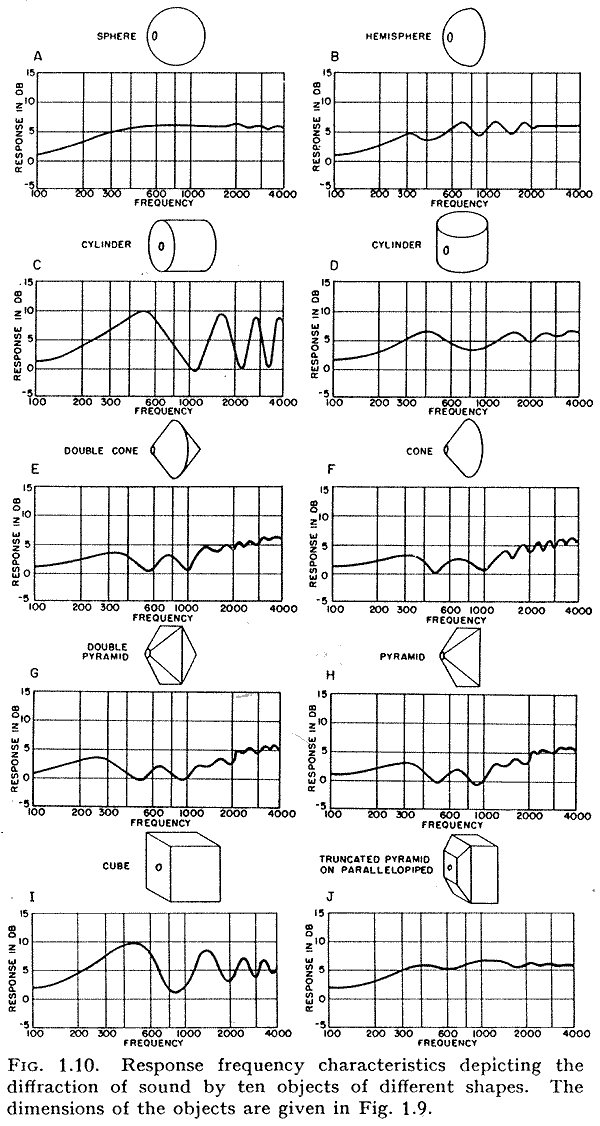
dave
Even if able to sacrifice some efficiency, I think you want to be very careful with application of active EQ to extend bass extension and output on drivers not designed to handle the accompanying additional suspension excursion and voice coil thermal dissipation most certainly to occur when installed in an undersized & maybe over-damped sealed box.
They say 30 watts nominal. It is a lot of power for my room. But not sure what effect does the smaller box have on driver resilience. I am happy to experiment, but would be disappointed melting the voice coils down.
Many thanks for the clarification. The picture showing the effect of shape is very interesting. Truncated pyramid is quite smooth compared to other shapes. Looks like beveling the front baffle could help a bit.
Sealed box done.
Sealed box, 12 liters, done. Listening period begins. My first impression is that there is plenty of bass. It is rather soft and does not go deep. In fact, there seems to be more bass than with previous ported prototype. It looks like it was tuned too high. Or there was some other issue with it.
I painted the box with black color. The result is rather ugly, but I can live wit it. Or better, not sure if I can do it better.
Sealed box, 12 liters, done. Listening period begins. My first impression is that there is plenty of bass. It is rather soft and does not go deep. In fact, there seems to be more bass than with previous ported prototype. It looks like it was tuned too high. Or there was some other issue with it.
I painted the box with black color. The result is rather ugly, but I can live wit it. Or better, not sure if I can do it better.
Attachments
Related question. When using a second rear firing woofer to counter baffle step does one have to cross to the woofers at the baffle step frequency to avoid upper bass bloat?
Also if one goes for a 2.5 way system instead how do you keep the impedance from dropping as the second woofer kicks in.
Also if one goes for a 2.5 way system instead how do you keep the impedance from dropping as the second woofer kicks in.
Depends on where the speaker is in the room and the aspect ratio of the box (related to bipole dip). For just BSC probably yes.
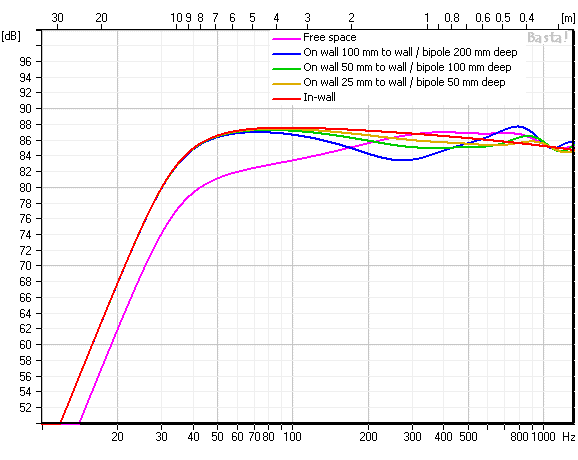
dave
dave
mashaffer, the rear fired woofer is fundamentally a 2.5 way, so yes you need to cut the top end. If you don't it's going to act more like a small baffle that sends midrange behind the cabinet.
You may see that as potential bloat (and in a sense that is correct) but sound below the baffle step doesn't get a free pass either.
You may see that as potential bloat (and in a sense that is correct) but sound below the baffle step doesn't get a free pass either.
Alpair 10p 12 liters box listening impressions
I was listening to my alpair 10p 12 liters sealed speakers for few weeks.
I was using two amplifiers (denon pma 600ne and cambridge audio cxa81) and was also using elac debut b 5.2 speakers for comparison.
The speaker sounded much better when oriented vertically. When it was oriented horizontally, it was obviously too bright. I believe this was related to front baffle dimensions and shape.
Also tried the speaker with parallel lr filter in series with the driver (r = 6.7 ohm, l = 1.5mH). It did help to compensate small box volume and I liked the sound more than without the filter. The bass was more present and resembled the sound of elacs.
Summarized, I think bsc filter did help to compensate small box volume, but probably had no effect on brightness of the speaker (probably caused by baffle). Is there a way to tame down the upper midrange a bit? I can’t exactly tell in what frequency range the issue lies, but female vocals are elevated so believe it is somewhere between 2khz and 4 khz. Trial and error approach seems only viable to me as I have no measuring equipment.
I was listening to my alpair 10p 12 liters sealed speakers for few weeks.
I was using two amplifiers (denon pma 600ne and cambridge audio cxa81) and was also using elac debut b 5.2 speakers for comparison.
The speaker sounded much better when oriented vertically. When it was oriented horizontally, it was obviously too bright. I believe this was related to front baffle dimensions and shape.
Also tried the speaker with parallel lr filter in series with the driver (r = 6.7 ohm, l = 1.5mH). It did help to compensate small box volume and I liked the sound more than without the filter. The bass was more present and resembled the sound of elacs.
Summarized, I think bsc filter did help to compensate small box volume, but probably had no effect on brightness of the speaker (probably caused by baffle). Is there a way to tame down the upper midrange a bit? I can’t exactly tell in what frequency range the issue lies, but female vocals are elevated so believe it is somewhere between 2khz and 4 khz. Trial and error approach seems only viable to me as I have no measuring equipment.
Attachments
Thanks for suggestion Norman.
I did some reading and found out something called Zobel network. It flattens out impedance curve meaning BSC filter should work better (its effect should vanish slower as impedance would grow slower). Some even advised to just put resistor in parallel with the driver.
But I am not sure if that would work and what another issues it would cause.
I did some reading and found out something called Zobel network. It flattens out impedance curve meaning BSC filter should work better (its effect should vanish slower as impedance would grow slower). Some even advised to just put resistor in parallel with the driver.
But I am not sure if that would work and what another issues it would cause.
- Home
- Loudspeakers
- Full Range
- Baffle step compensation circuit for bookshelf speaker

